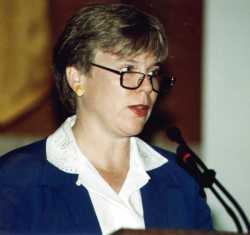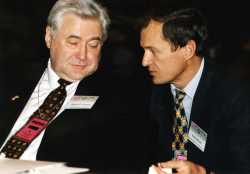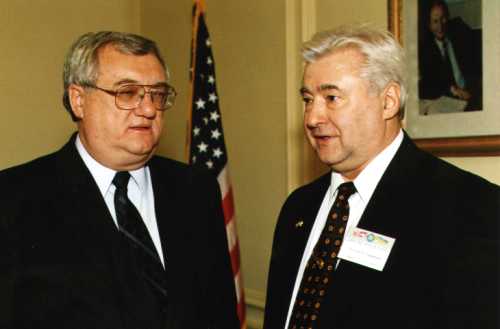
| November 1998 | - Armenia
- Bulgaria - Czech Republic - Hungary - Kazakhstan |
- Lithuania
- Russia - Slovakia - Ukraine - United States |
- Cross-Cutting Activities
- Planned Activities - Previous Activity Reports |
The November Activity Report documents safety improvements achieved in late October and November at Soviet-designed nuclear power plants through U.S. and host-country cooperation. To request a hard-copy version or to provide comments or suggestions, send an e-mail message to andrea.currie@pnl.gov.
Monthly Highlights
Ukrainian Firms Showcase Commercial Nuclear Technologies for Potential U.S. Collaborators
The U.S. Department of Energy, in coordination with the U.S. Department of State and U.S. Agency for International Development, hosted a U.S.-Ukraine Conference on Nuclear Trade and Cooperation on November 9 and 10. The conference was held in the Diplomatic Conference Room of the State Department in Washington, D.C.
Rose Gottemoeller, director of DOE's Office of Nonproliferation and National Security, was the keynote speaker for the United States. Ukraine's First Deputy Minister of Energy, Mikhail Umanets, led the 50-person Ukrainian delegation and spoke on new directions in the Ukrainian nuclear sector.
 |  |
| Rose Gottemoeller, director of DOE's Office of Nonproliferation and National Security, challenged conference participants to establish foreign investment opportunities in Ukraine. | Ukraine's First Deputy Minister of Energy Mikhail Umanets (left) listens as Yuri Kostenko, chairman of Ukraine's parliamentary subcommittee on nuclear power, discusses information presented at the conference. |
Approximately 150 representatives of U.S. companies associated with the nuclear industry also attended the conference, where they heard technical and commercial presentations by officials from Ukrainian nuclear firms and institutes. The Ukrainian presentations focused mainly on Ukrainian commercial nuclear technologies and their potential for application in the United States.
The conference began with a special half-day session on the U.S. nuclear industry for Ukrainian participants only. The session featured overviews by representatives from various sectors of the nuclear industry. The balance of the conference, which was open to all participants, began with a presentation on the Ukrainian nuclear industry and opportunities for U.S. business. Ukraine's ambassador to the United States, Dr. Yuri Shcherbak, hosted a reception for all conference attendees at the Ukrainian Embassy on November 9.
 |
| Departing Ukrainian Ambassador Yuri Shcherbak (left) confers with Mikhail Umanets, Ukraine's First Deputy Minister of Energy, at a reception hosted by the Ambassador at the Ukrainian Embassy. |
After the formal technical sessions, which concluded late November 10, DOE arranged three-day visits to U.S. nuclear firms and sites around the United States for all Ukrainian participants. U.S. firms hosting these visits included Westinghouse Electric Company (both Pittsburgh and the Utah zirconium facility), Duke Engineering & Services (North Carolina), General Electric, Burns & Roe Enterprises, Scientech, the Electric Power Research Institute, Motorola, Morrison Knudson, Siemens, Bechtel, and WahChang of Portland. DOE national laboratories serving as hosts were Pacific Northwest National Laboratory, Oak Ridge National Laboratory, Brookhaven National Laboratory, and the Savannah River Radioecology Laboratory. (Mike Congdon, PNNL, 202-646-5285)
Kazakhstani Nuclear Technology Safety Center Initiates Safety Review Process
Specialists from the Nuclear Technology Safety Center in Almaty, Kazakhstan, completed their first major task as part of a U.S.-supported workshop at the center November 6 through 10. The purpose of the center, which was established by Kazakhstan earlier in 1998, is to perform independent safety analyses of the country's nuclear facilities. The U.S. team is providing support for infrastructure development for the fledgling center.
Three U.S. specialists presented the workshop, which offered training on performing safety analysis reviews. Approximately 10 Kazakhstani experts from the center, the Aktau nuclear power plant (BN-350 reactor), the National Nuclear Center of Kazakhstan, and the Kazakhstan Atomic Energy Agency (KAEA) participated. As part of the workshop, the instructors used the Final Safety Analysis Report (FSAR) for BN-350 Spent Fuel Packaging as a teaching example. Instructors formally documented review questions and responses. Center specialists then completed an evaluation of the safety review and presented it to the KAEA to use in its licensing decision on the proposed spent-fuel packaging operation. The November workshop was the first in a planned series of three for the Kazakhstani specialists at the center. (George Imel, ANL, 208-533-7559)
Bilibino Implements Two Training Courses for Nuclear Power Plant Workers. In mid-November, training staff from Bilibino nuclear power plant (NPP) implemented two courses for plant workers. Instructors taught the courses--Shift Supervisor and Instrumentation and Control Technician--at the plant for the first time during the week of November 16. The week before, U.S. and Balakovo NPP training specialists worked with the Bilibino NPP training staff to finalize the instructional materials developed over the past year for the two courses. The visiting specialists also collaborated on practice teaching sessions with the Bilibino trainers. Implementation of the two pilot courses at Bilibino represents completion of the first phase of the U.S. project to transfer training technology to Soviet-designed NPPs in Russia. (Peter Kohut, BNL, 516-344-4982)
Progress Reviewed for Smolensk Safe-Shutdown Study. The coordinating committee for the Smolensk safe-shutdown study reviewed project progress during an early-November meeting in Islip (Long Island), New York. Committee members include representatives of Russian organizations GET/VNIIAES, Atomenergoproekt, and Smolensk NPP, as well as U.S. team members from Bechtel National, Inc., Engineering Planning and Management, Inc., and DOE's Pacific Northwest and Brookhaven national laboratories. Committee members reviewed and discussed two task reports prepared by Smolensk analysts as part of the study:
Subsequent discussion centered on the analysis of circuits associated with the plant's safe shutdown systems. Because Smolensk Unit 3 has more than 50,000 cables, the circuit analysis is particularly challenging and taking more time to perform than expected. Russian analysts presented their approach to performing the analysis, and coordinating committee members provided comments on the approach. The group agreed that a report on the task, Associated Circuit Analysis, will be submitted by the end of December. During the second phase of the project, the team will do the final analysis of associated circuits in which spurious operation could present problems. The meeting adjourned following preliminary discussion of plans for that second project phase, which will include the deterministic analysis. (Andy Minister, PNNL, 509-376-4938)
Progress and Plans Discussed for Kola In-Depth Safety Assessment. In Moscow in late October, the steering committee for the Kola in-depth safety assessment reviewed results of the preliminary quantification done for the Unit 4 probabilistic risk assessment. Group members agreed that the probabilistic risk assessment for Unit 4 will be completed by spring 1999. The committee also discussed plans and work scope for the deterministic safety assessment for Kola Units 1 and 2. (Phil Pizzica, ANL, 630-252-4847)
Novovoronezh In-Depth Safety Assessment Reviewed. During the project's steering committee meeting in Moscow on October 22 and 23, Russian analysts reported on status of the in-depth safety assessment under way at Novovoronezh NPP. The group then moved to the plant site for project-specific discussions October 26 through 30. During those discussions, Novovoronezh representatives signed the task order for the Level 1 internal events probabilistic risk assessment for Unit 3. Participants agreed upon the schedule for the probabilistic risk assessment and began the technical work. The technical guidelines and systems descriptions already are nearly complete. To accelerate project progress, participants also agreed upon a schedule of increased presence at the plant site by U.S. team representatives and Russian supporting organizations, primarily Atomenergoproekt. (Phil Pizzica, ANL, 630-252-4847)
International Reactor Safety Analysts Exchange Information. The third annual Information Exchange Forum on Safety Analysis for Nuclear Power Plants of VVER and RBMK Type took place October 26 through 30 in Obninsk, Russia. U.S. team members from Argonne and Pacific Northwest national laboratories and representatives of the Institute of Physics and Power Engineering (IPPE) in Obninsk organized the meeting to "...foster the exchange of information among persons working in the area of safety analysis." IPPE hosted the exchange. Other cooperating organizations were the International Atomic Energy Agency, the Nuclear Energy Agency of the Organization for Economic Development and Cooperation, the Swedish International Project-Nuclear Safety, and the Kernforschungszentrum Rossendorf of Germany.
Approximately 110 persons participated in the exchange. Most participants were from Russia and Ukraine; others represented Armenia, Bulgaria, Germany, Lithuania, Romania, Slovakia, Sweden, and the United States. Observers noted that this year, a larger number of participants represented operating nuclear power plants. Approximately 60 papers were presented during the exchange; most dealt with the work being done in support of DOE's efforts to improve the safety of Soviet-designed nuclear power plants (see next article). (Jan van Erp, ANL, 630-252-3381)
Code Validation Work Presented at Safety Analysis Information Exchange. U.S. and Russian experts gave eight presentations on work to validate computer codes for application to VVER and RBMK reactors at the Information Exchange Forum on Safety Analysis for Nuclear Power Plants of VVER and RBMK Type held in Obninsk (see article immediately above). The presentations included an overview of the code validation projects, summaries of the two validation plans developed, and results of analyses by Russian and U.S. teams of the first two standard problems for VVER and RBMK applications, respectively. Representatives of the Electrogorsk Research and Engineering Center, the Kurchatov Institute, and Argonne, Idaho, and Pacific Northwest national laboratories gave the technical presentations. (Jordi Roglans, ANL, 630-252-3283)
Code Validators Compare Analysis Results, Plan Future Work. U.S. and Russian nuclear safety analysts met at the Russian International Nuclear Safety Center (RINSC) in Moscow on October 29 and 30 for technical discussions related to the code validation projects. The talks focused on results of independently conducted analyses of the first two standard problems for VVER and RBMK applications. Russian participants in the code validation projects include analysts from the RINSC, the Kurchatov Institute, and the Electrogorsk Research and Engineering Center. Those analysts and U.S. specialists from Argonne, Idaho, and Pacific Northwest national laboratories participated in the comparative assessment and ensuing planning. Team members developed a template for the comparative assessment reports for the two standard problems. They will communicate via electronic mail to complete the reports. During the meeting, participants also finalized the schedule and syllabus for the upcoming training in code configuration control and maintenance. (Jordi Roglans, ANL, 630-252-3283)
Project Guidelines Completed for Rivne Safety Assessment. Project staff for the in-depth safety assessment under way at Rivne NPP completed project guidelines documents in November. The guidelines describe procedures for developing the input decks for analyses to be done with the ORIGEN and MELCOR computer programs and for performing the design-basis accident analysis. With the procedures now defined, team members can begin the calculations for the Rivne Unit 1 design-basis accident analysis. (Charles Dickerman, ANL, 630-252-4622)
Ukrainian Specialists Complete Probabilistic Risk Assessment Training. U.S. team members from Scientech, Inc., and Idaho National Engineering and Environmental Laboratory (INEEL) presented a two-week course on probabilistic risk assessment methodologies to Ukrainian specialists in Kyiv during November. The course consisted of two parts. In the first, Scientech staff introduced 24 participants to the concepts and methods associated with probabilistic risk assessment. The second part consisted of hands-on training in application of the SAPHIRE computer code. Staff from INEEL, where the SAPHIRE code had been developed, provided the hands-on training to 15 participants. The two-week course was intended primarily for Ukrainian specialists who will participate in peer reviews of in-depth safety assessments conducted for Ukrainian NPPs with VVER reactors. (Christian A. Kot, ANL, 630-252-6151)
Armenia Implements One Training Course, Begins Developing Another. Training specialists from the United States and the International Atomic Energy Agency worked for two weeks in November with Armenia NPP training staff, preparing for and implementing a training course at the plant. During the week of November 16, Armenia NPP trainers offered the control room reactor operator course for the first time to plant personnel.
During the same time frame, U.S. specialists and the Armenia NPP trainers began developing necessary instructional materials for a second course, Radiation Protection Technician. This course is the second of four training courses the U.S. team plans to transfer to Armenia NPP.
The U.S. Department of Energy and the International Atomic Energy Agency jointly support the project to transfer training technology to Armenia NPP. The work is aimed at enhancing the safety of plant operations through the development of more effective training courses and instructional materials for plant workers. (Peter Kohut, BNL, 516-344-4982)
Work Begins on Armenia Safety Parameter Display System. From November 17 through 19, staff of Burns & Roe Enterprises, Inc., and Science Applications International Corporation (SAIC) worked with personnel from Armenia NPP to develop specifications for a safety parameter display system (SPDS). Armenia plant representatives previously had visited Novovoronezh Unit 3 in Russia to examine the SPDS that became operational there last month. The Armenia SPDS will be nearly identical in design to that of the Novovoronezh Unit 3 system. Project team members will complete the database of input signals for Armenia NPP by December 15. With support from the Russian organization ConSyst, SAIC specialists will develop the final design for the Armenia system. The project team will assemble and test the system at SAIC facilities in the United States. Installation of the SPDS at Armenia NPP is scheduled for the September-October 1999 outage. (Rich Denning, PNNL, 614-424-7412)




